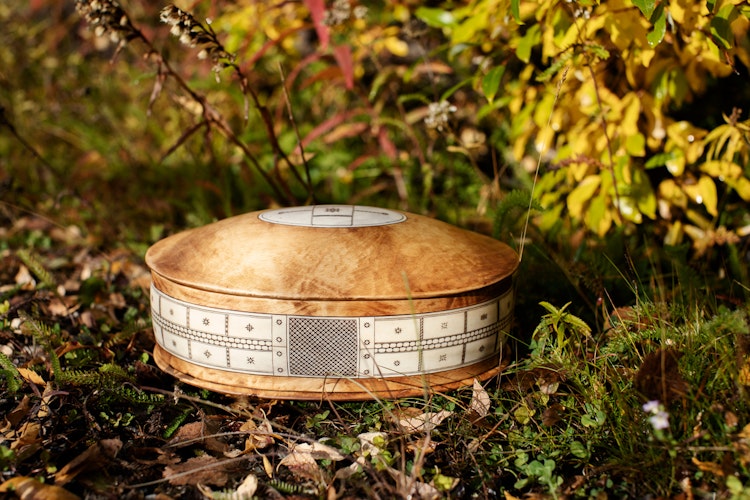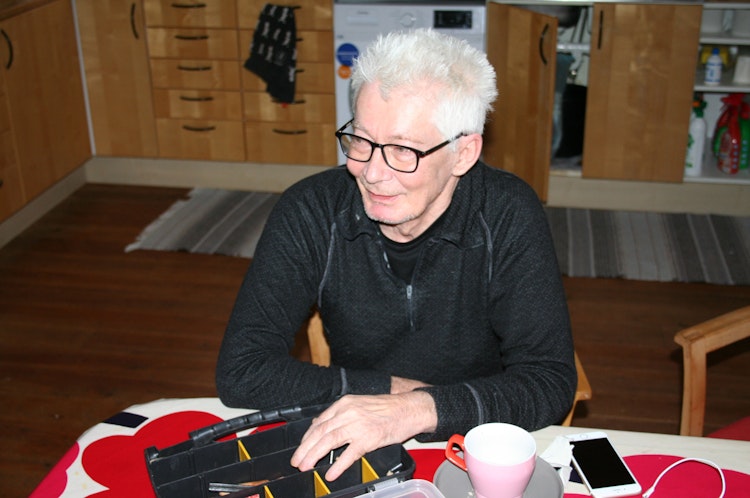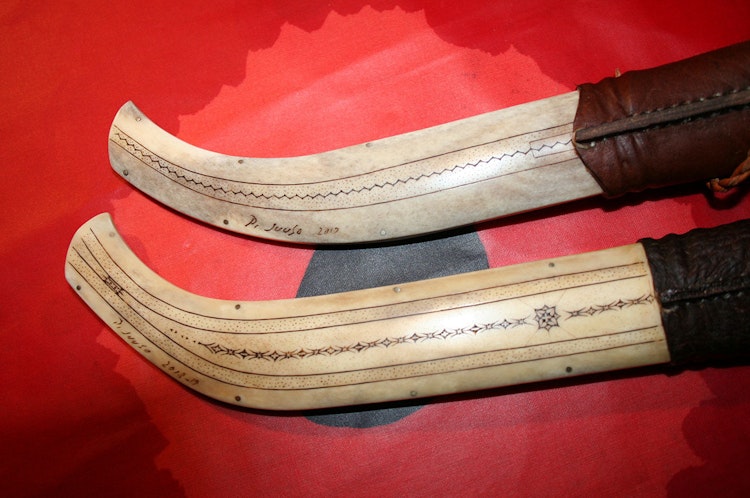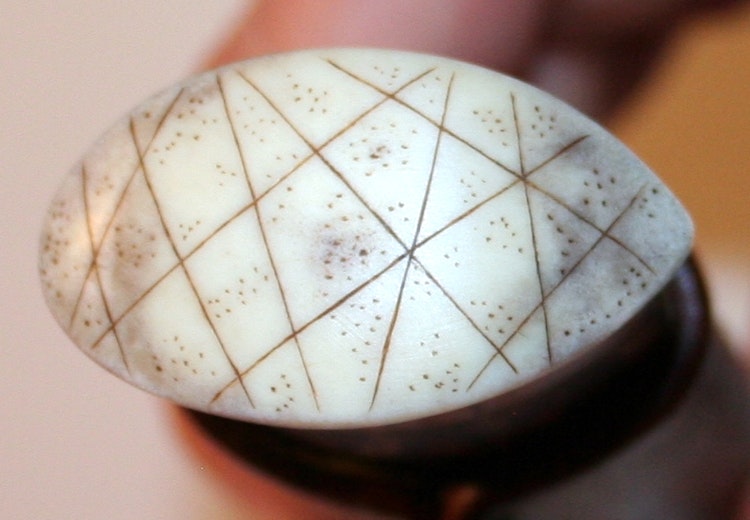

Irene Snarby
Irene Snarby
In this conversation, Irene Snarby talks to duojar Perisak Juuso about the landscape and Sámi place names, and about the in-depth knowledge you need in order to find the right burls, roots or antlers to make beautiful duodji.
It was a cold morning in early February when my husband Dag and I set out from Tromsø, a town located on the northern coast of Norway. Before us was a journey through Sápmi, through three countries, before we finally arrived at Perisak (Berissat) Juuso's home village, Mertajärvi, in the northernmost part of Sweden. Our trip gave us heavy snow covering almost all that we could see, reindeer, moose, and foxes that suddenly jumped onto the road in front of the car, and a breathtaking sunset at about one o’clock, before we finally found the house, where hot coffee and exciting stories awaited.
There have been a number of discussions about what separates duodji and dáidda (the Sámi word devised in the 1970s for the Western term “art”) at various events and in academia. This is not an article about that. This is a conversation with Perisak Juuso, which also took a different turn than expected. We were going to talk about art, and so we did; but it became just as much a conversation about place. Landscapes that are part of us, about boundaries that separate, and about oblivion. I myself have a large Sámi family primarily on the Norwegian side, through my mother's family; but we talked more about the island town of Tromsø, and the village my father’s family originates from on the mainland called Stuoranjárgga in Sámi. Because here in Mertajärvi, many miles from the sea, in the Könkämä area in the Swedish county of Kiruna, there are Sámi descendants of those who were denied the right of return to their homes in the summer lands on the Norwegian side that they had used since time immemorial, due to restrictions negotiated in 1919 by Sweden and Norway and implemented in 1923. In Tromsø we were taught that they were Swedish Sámi, but they did not even speak Swedish, they spoke Sámi and Norwegian. One of their descendants, Elin Anna Labba, writes: “It was Tromsø’s own citizens they forcefully displaced from the area.” This may have been forgotten or minimised by the Norwegian townsfolk, but not by those who were forced to leave.

A fishing boat on the sea
When we arrive, Perisak has mounted a sculpture on the table, and he tells us that this is a sjark, a fishing boat on the sea.2 The sculpture consists of two parts. The main part is made from wood and has an abstracted, hollowed boat shape, almost like an oval bowl, in a marvellous maroon colour. Attached to the back of the boat is an ornamented, triangular piece of moose antler. It is precisely this small piece of horn that gives the sculpture its meaning. It represents a sail, says Perisak, which is found on every sjark throughout northern Norway. My husband Dag suddenly becomes excited — he has been fishing quite a lot at sea, and he recognises it as a mesan sail, which stabilises the boat in side winds. He explains that if you have the sail catching the wind, you can save tremendously on fuel. Perisak smiles and says it is good to meet someone who knows this. He mainly likes it for its beauty. But he is concerned that all these small fishing boats will disappear. He believes that the big companies will take over all fishing in northern Norway, the Arctic Ocean, and everything; the small ones will disappear in a few years.
The boat is carved out from a čuolbmabáhkki, which directly translates to “problem burl”, a special burl that grows in clumps on birch trees. This troublesome material becomes beautiful when it is ready, but is extremely hard and difficult to work with. Perisak tells us that you have to wait patiently during the drying process as well. When you start forming the piece, you have to calculate how it may shift in different directions, and you have to save some materials in order to adjust it into the shape you are looking for. After carving, drying, and polishing, he lubricates the wood with a mixture of dried birch bark that has been powdered and boiled with water until it has the colour and texture of syrup. Then he starts with the next object. It is the most effective and least harmful way to carve fresh wood by hand. He basically only has dry materials in storage, and relieves his tired hands from working with machinery by handling the wood in these ways.

Two knives
Along with the boat sculpture are two knives that came home to Perisak from an exhibition at Sámi Dáiddafestivála (the Sámi Art Festival) in Alta only the day before. The traditional shapes are called gavvarisdohppa and njuolgodohppa, named after how much the sheaths are bent.3 The knives are made of birch root, moose antlers, and damask steel; the sheaths are made of antlers and cowhide. Perisak likes to use cowhide because it is stiff and hard. They use the same hides in the interiors of expensive cars, like Rolls-Royce. He explains that reindeer hide is usually softer, if you cannot find a large and old reindeer bull you can use cowhide. The largest sheath’s leather is naturally dried, and probably tanned with spruce. It is not stretched in a factory, like the leather of the smaller knife. It takes a lot of skin to make this because it shrinks a lot, and it is really hard to work with.
The birch root in the shaft has a more marbled structure than the čuolbmabáhkki. This kind of birch root is quite difficult to find, Perisak tells us; you must consider carefully where you can dig. When you search the slopes and see a stem with a slight elevation before the birch goes down into the field, it can be worth a look. The small rise is a kind of compensation of the root that grows to stabilise the birch. They cannot be found on the plains; it is never easy and there will always be a lot of climbing. Perisak says that there are many birch roots by the fjords that are large, dense, and fine. We agree with him, knowing the conditions in our home area in Tromsø, where large birches grow out of the ground and bend up into an arch. This is of course not new to Perisak, as his family has had summer lands in the fjords close by.
The loss of summer land and the old names
Our conversation turns to what has happened to the Sámi place names in these areas. In the mainland area in Tromsø, there is a big mountain that the Sámi call Áddjitgáisa, the father of Stuoranjárga (Sveen). This name is connected to myths, religion, and the function of the area. Perisak still remembers the reindeer herders’ names, and in which area they had their animals, and why they had to leave. It is common knowledge here. Strangely this place did not get its old name back when the villages around Tromsø got signs with both Norwegian and Sámi names. Instead, a new, unknown name, Snárdut, was given to the place. It seems to be a Sámi-like translation of the Norwegian name Snarby, my father’s family name. The old name that gave sense and meaning to the area and which was connected to the history of the place was ditched. Perisak knows for sure that the new Sámi name of the neighbouring village is completely wrong. Its new Sámi name is now Baikajohkka, which translates to “Poop River”. In Norwegian, the place is called Skittenelv – “Dirty River”. As we can see, it is a poor and misunderstood translation, probably from a much older translation, that makes the people who now live and work there feel ashamed. We wonder how this could happen. Why are we not allowed to be proud of the Sámi names? Perisak says it could be a lack of knowledge, as few people know to what extent Tromsø was Könkämä Sámi summer country. All the areas around Tromsø had Sámi names, but Norwegians have suppressed this, and now it seems that when they can’t find knowledge from sources one click away on the internet, they abandon the effort. Our laughter is bittersweet when we conclude that it must be someone in the south of Norway making this mistake.

Talking about antlers and engraving
Perisak returns to his knives and explains the importance of picking the right antlers for the right purpose. It takes ages to learn to read an antler. You cannot read in a book how to figure out the right shape. There are also strict rules for how you can work with the design. His area uses the Könkämä traditional engraving. This belongs to the Northern Sámi tradition, not the Southern or Central Sámi, which have different designs. Perisak is concerned because many duojárs nowadays use various engravings and shapes mixed together. It leads to confusion, like mixing three languages together. No one understands each other because of this mix. The shapes may be right, but then the engraving is something else entirely. I suggest that it might be the duodji training programmes that give opportunities to experiment with others’ designs. That the teachers might come from different areas. Perisak agrees, but being a teacher himself this really upsets him; he would never encourage the mixing of traditional designs from different areas — but, this does not mean that you cannot experiment within your own practice. Perisak would not be the master he is if he had not developed his own distinct style. With deep respect for his roots, and his ancestors’ work, he allows himself room for change. He explains how he, after making numerous knives, started to develop a new kind of engraving, still based on the Northern Sámi style. This traditional style is often quite heavily decorated and involves engraved flowers in the middle of the sheath, and then it continues with bands, and then there may be some flowers again. But here he has thrown the engraving into the air, then caught it and placed a little here and there. He picked away the bands, stars, and flowers, and what is left are central protrusions that run over the sheath all the way down to the shaft. The engraving includes small continuous triangles which look like a mountain range, and the many dots enhance the impression of a landscape, like stars in the sky; a heavenly vault. The many dots are made to highlight this and create a whole. He tells us that an architect who admired his work said he had created a postmodern engraving. Both sides of the knives are decorated in this special fashion that continues on the shaft. Traditionally, knives do not have engraving that continues from the sheath to the shaft; one simply engraved the sheath. Perisak says that he will work on further dissolving the patterns into only lines and dots, like on the top of one of the knives. He is a great admirer of Indigenous peoples’ ways of producing images and stories. He thinks that if this, for instance, had been shown to an Australian Aboriginal person, he or she would have understood it all; these are the paths and tracks the Ancestors used. I interrupt him, saying that as an art historian I see a kind of Picasso style in the pattern. Perisak replies that Picasso was the first to take Indigenous art and transform it into his own images.
The knives we look at today still have a few of the traditional patterns, like flowers and stars, engraved with incredible precision. One of the flowers is reminiscent of a stohpu, from the drawings on ancient holy drums that looked like houses or buildings. Yes, it's a roof, Perisak agrees; a Japanese roof. When I make bowls or skáhppu, I’m inspired by Japanese roofing. Sometimes the pattern is added to the antler in order to hide an imperfection like a vein. He shows me where he had to do this on the knife, then he makes me aware that the large antlers he has used are actually quite difficult to find, having saved these ones for almost 30 years. Getting good stock takes a lot of time, and this is something a duojár constantly works with. You do not take any kind of antler. It is a bad idea to use an item that is not fit for a knife. It must be dense, with as little an amount of porous marrow as possible. The material closest to the head and around the antlers are most often the hardest. The amount of marrow in the horns says something about the pasture condition in the spring; the less marrow, the better the pasture. Perisak tells us about many of the different names of the reindeer, depending on how old they are, and how they look; this is something a duojár must know. Another important thing is that you must never take the antler of a female deer, an áldu. They lose their antlers in the summertime when they have calves, and return to the same place the following year, to feed on the old antlers to gain strength before again giving birth. I realise that this is exactly what is happening in my home area, where new reindeer from the Norwegian side give birth. The knowledge was something the elders explained; never touch the antlers of an áldu because she needs it when she comes back. It's the only thing you can't touch, the rest you can take. Antlers are after all just minerals; often one can find piles of large male deer horns, but never the antlers of an áldu.

Perisak makes all the equipment he needs for engraving himself, with numerous different knives for different uses. I really admire his precise work, but after many years of training he finds this quite easy. Fresh antlers are easy to engrave, but he only works with old and hard antlers; still, the most difficult part is to create the right shape. Studying the knives thoroughly, I then ask if he thinks his Ancestors would have recognised these knives if they saw them? “Yes,” he replies, “they would recognise the shapes, but the engraving ... what the hell, are you drunk?!”
Back to Tromsø
We then return to talking about Tromsø. Perisak remembers the stuffed polar bear in the main street. For his family, Tromsø was the city itself, the place of business and trade; that's where they bought everything, and he clearly remembers that as a child he had never seen so many houses. Just after the Second World War, his grandfather went to Tromsø and bought four rolls of English cloth to sew the traditional Sámi costume gákti for his family and relatives for several generations. Perisak still has a gákti of this cloth that his mother made for him. In those days the reindeer in his family’s herd were huge.
He tells us that before the war you could recognise the reindeer without looking at their marks, and you would know which family they came from.4 Some families’ reindeer had long bodies, others had dots and special colours. It made recognising them easy. After the war, the pasture in Norway became even more restricted, and everything changed. In summer the herds were merged into a collective, and the herds changed, they became more similar. Today it seems like no one does proper breeding work. Because it was a very advanced breeding work. You saved what you wanted; but it is all over now. Perisak believes the nation states do not accept that people have been here for thousands of years; they just want access to the land to build wind turbines and dig out mines and destroy it in every way. He thinks they destroy the fjords, and he is concerned about the situation for the Sea Sámi people. Many of them are former reindeer herders who changed their occupation to fishing. They had relatives who took care of their reindeer as well. It was convenient to have someone fishing in the family, then you also had fish, he says.
A humorous greeting
On the kitchen wall hangs an object that amused both me and my husband when we came in. It is a cranium of a moose, with orange rakes mounted on the sides instead of antlers. It is made as a humorous greeting to his moose-hunter friends, but this also shows how a Sámi duojár can make objects that are not pure duodji, but which move in the direction of art, dáidda. While traditional duodji has rules to be followed, the dáidda gives another sort of freedom — to be able to play and sort out alternative solutions. If he has to be pushed to draw a line between duodji and dáidda, Perisak says, he considers duodji to be the real art, and from there the pictures or dáidda evolved. In his living room is another moose cranium decorated with brushes; we laugh when he tells us that he can brag about having the moose with the most tines. Just before we leave, Perisak shows us a gigantic antler he has kept for 40 years in a separate room. It comes from an old reindeer bull about 10 years old. I have never seen anything like it. It’s like from another world and is so strange, because such large reindeers are no longer bred.
It was truly fascinating to be invited home behind the scenes, to see the machines, tools, and all the burls and roots and other items just waiting to become art in Perisak’s studio. The sharing of knowledge that we experienced was truly generous, and the way he cared about the old summer land of Tromsø and Stuoranjárga was touching. I only wished we had even more time. Seeing gigantic antlers that are so rare today makes me realise more than ever that I have seen so little. I have only experienced a tiny little bit of this world. Our world.